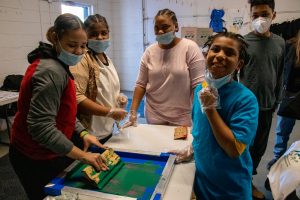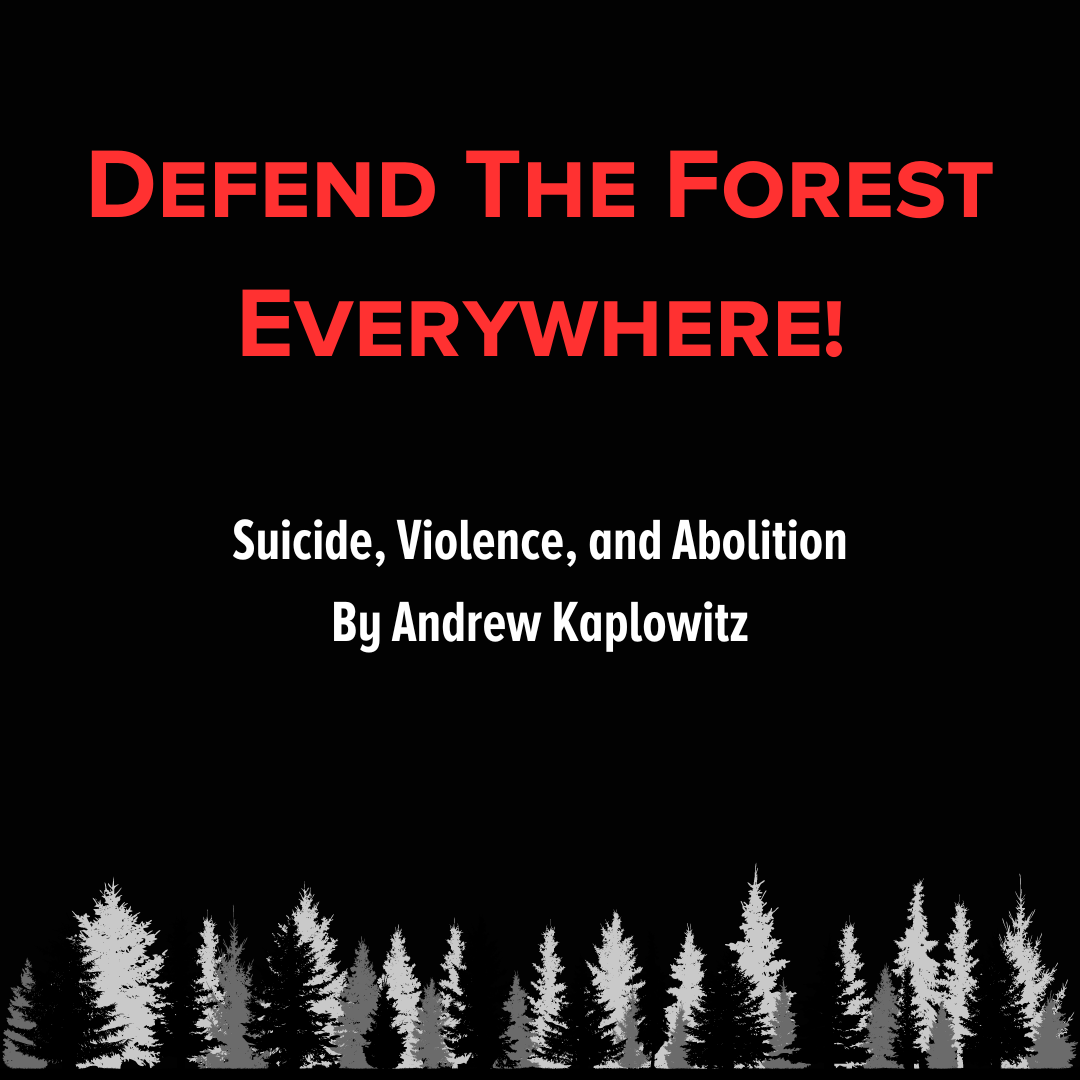This March, thirty-four organizations in Detroit signed on to a statement in solidarity with the abolitionist #StopCopCity protests in Atlanta, denouncing the police killing of innocent people, calling to defund the police, and making explicit the connection between the environmental and racial justice movements. The same week that the Detroit Stop Cop City Coalition hosted a series of solidarity actions, I found out that Matthew Ethington II, a high school classmate of mine, killed his wife Maria Martin before committing suicide, leaving their child alone in the house with their bodies. Ethington and Martin were both police officers with the Detroit Police Department and this coincidence made me reflect on the relationship between suicide, violence, and abolition.
Ethington’s case is part of a growing trend – suicide rates increased 30% between 2000 and 2018, and despite briefly dropping in 2019 and 2020, the rate is increasing again. There are, unfortunately, many valid reasons for feeling hopeless – from the scope of climate change, to the growing rate of mass shootings, to the 50-year trend of an increasingly underpaid working class that leaves families struggling to meet their needs. And this hopelessness speaks to a gaping hole in our communities’ ability to provide for each other’s mental health and overall well-being.
But Ethington didn’t just kill himself—he chose to take the life of his wife and leave a child parentless. The decision for someone to end their own life is upsetting, but undeniably different from choosing to end another person’s life. Like most of us raised in the United States, Ethington was socialized to view anger as one of a few appropriate emotions for men to display, to implicitly believe men should control women, and to embody other aspects of toxic masculinity. Conflicts, disappointment, fear, and anger are a part of life, but people choose how they react to these emotions and situations. The actions we ultimately decide to take are shaped by our lived experiences.
Ethington was a police officer who lived in a culture of violence and impunity, it became him. Research shows that Ethington is part of an established pattern of police domestic violence and murder. Ethington made a choice based on how he understood the world and its possibilities, a choice influenced by his experience as a police officer. Whatever precipitated Ethington’s actions, he didn’t solve any problems by choosing to kill Martin but nevertheless he opted for the same tool he was trained to use at work every day: violence — a physical force exerted to cause harm or injury.
The intimate relationship between policing and violence will inevitably shape the outlook and decisions of officers. Police are trained, authorized, and expected to control situations with violence or the threat of violence (and there’s a noteworthy similarity in the way abusers use violence to control their spouses). This is made apparent by laws that establish felony charges for failing to comply with a police officer, by official policy and tools like “pain-compliance” or “less-lethal ammunition,” and by routine illegal practices from choke-holds to police gangs. Police are also protected when they use violence unjustly.
The violence inherent in policing is often justified by pointing out that interpersonal violence is a fact of life. This is true. Violence will occur in any society, and police respond to these situations. However, it is precisely because violence may be unavoidable at times that necessitates investigating whether our responses to violence are actually reducing the cumulative amount of violence we are experiencing or preventing violence from happening in the first place.
In Uvalde police responded to an active shooter ineffectively. During the active shooting, police failed to interrupt a massacre, opting instead to control the situation outside the school by detaining parents who were eager to intervene. One detained parent escaped and rescued her children while police waited on their phones. This exemplifies the police’s inability to interrupt violence and incompetence at creating order. Additionally, it demonstrates that an ordinary citizen did more to save the lives of innocent children than the police. This parent’s actions also highlight the tendency of everyday people to step up in defense of each other even at great personal risk.
The tendency of police to make situations less safe is widespread. While responding to a traffic stop in Buffalo, police officers pursued a Black individual in a high speed chase, shooting hundreds of rounds of ammo (some from moving vehicles) despite orders to stand down, acting against department policy. The result was that two police officers were hit with friendly fire and police fired an untold number of bullets into populated areas. The risk to civilian life was greatly increased by the callous actions of the police. No officers are being charged.
The police responses in Uvalde and Buffalo are examples of some of the flaws inherent in policing: a focus on control at the expense of ensuring people’s safety, and abuse of power with a lack of accountability. Not only are police ineffective, but all too often police make situations more dangerous. The lack of consequences for police officers emboldens bad decisions.
This was demonstrated again in Atlanta, where earlier this year a Georgia State Trooper shot and killed Manuel Terán, also know as “Tortuguita,” a protestor with #StopCopCity, during a raid. There is still an open investigation into the shooting, but new evidence suggests Terán was shot at least a dozen times while sitting cross-legged with their hands in the air. Until the police showed up, Terán was alive and living in harmony with their community in the forest.

The #StopCopCity movement is a broad coalition of organizations, individuals, and affinity groups in Atlanta who are resisting the police takeover of a 265 acre park to build an 85 acre urban combat training facility. In addition to the frustrations with more funds going to police, there are environmental concerns, as the forest helps improve air quality and mitigates flooding damage to the nearby Black communities and is one of Atlanta’s largest green spaces. Studies show access to green spaces offer numerous mental health benefits, while police interactions negatively impact mental health. The protestors, some of whom have been occupying the forest for two years now, are also organizing public pressure campaigns to get contractors to pull out of the development deal, and calling for solidarity actions across the globe.

The fight over the Atlanta forest is similar to other struggles against militarization and ecological destruction with corporate interests bankrolling an ecologically destructive development in concert with a police force on their payroll. Another example of this is the Northern Lights Task Force in Minnesota, where an interjurisdictional group of police officers received millions of dollars to act as private security for Enbridge during the construction of the Line 3 oil pipeline. During my time there I saw school resource officers’ vehicles parked on site and sheriffs drinking smoothies in lawn chairs under sun umbrellas on the worksite.
Police violence is inherently tied to racial violence as a means of economic and political control. In fact, the struggle against police violence in the United States runs as deep as slavery and Native American genocide, and we must reckon with that legacy if we want to live in a world where violence is an anomaly instead of the norm.
Nationwide police are receiving more funding — even in light of these institutions’ failures to improve the quality of life for individuals and increasingly obvious abuses of power. The State’s willingness to repress justice movements in defense of capital is apparent in the dozens of domestic terrorism charges that concert-goers and protestors have received in Atlanta over the past few weeks and the governor’s decision to call in the National Guard to suppress protests. The murder of Terán fits a broader trend of occupations and Indigenous people being murdered for resisting corporate overreach and nonviolent direct actions being met with violent suppression, both globally and domestically.
Environmental justice is as much of a life-or-death struggle as any war between nations. Not only do climate change related deaths outnumber those that come from war, but militarization and wartime actions exacerbate climate change. A movement toward peace is also a movement toward climate repair, as the U.S. military is the largest polluter in the world. Investments in policing, surveillance, and military expansion at this time clearly show that the United States’ policy in response to climate change is to increase policing, control, and repression, rather than respond to the needs of the people or take meaningful actions to halt ecological destruction.
The Detroit Stop Cop City Coalition solidarity statement identifies parallels between the Detroit Police raid on the Indigenous-led sugarbush (maple syrup making) ceremony in Rouge Park last year; the killing of Black people across the nation, including the killing of Porter Burks, a Black man in a mental health crisis in Detroit; as well as the Michigan National Guard’s attempt to take over hundreds of miles of land with a proposed (and widely opposed) Camp Grayling expansion. These local connections reveal the ubiquitous nature of state-sanctioned corporate exploitation that incense the majority of the public and defy common sense.
The solidarity statement is supported by a diverse group of supporters, suggesting the growing capacity for broad solidarity among groups with different focuses and individuals from various backgrounds. Hundreds of attendees at the events hosted by the Coalition discussed abolition, racial justice, and environmental justice topics, while building local and international networks and curating intergenerational spaces for art and culture. These events bolster hope for a key component of abolition: the creation of a dual power. Or in other words, the building of alternative spaces, organizations, and institutions that can serve as a dependable alternative to violent and abusive police.
And still, abolition is about more than fighting oppressive violence—abolition is also creating care-centered communities. The path to abolition is a path of healing. The questions at the forefront of our conversations focus on how we support one another through the challenging times, how we respond to harm, how we interrupt violence without stepping into the role of the police, and how we deal with failure in pursuit of our ideals. We must live in the contradictions of our utopian dreams and the challenges of being human, but we know that the path to healthy sustainable communities is only traversable if we work together.
Bio: Andrew Kaplowitz is an artist and activist living in Waawiyatanong (so-called Detroit) on Anishinaabe land. Their work to build healthy and sustainable communities takes many different forms.
IG: @kplwtz Website: https://kplwtz.wixsite.com/mysite


